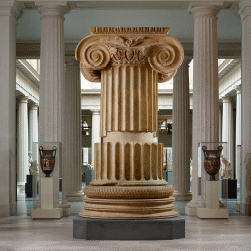Introduction
The example that will be discussed in this paper is a section of the marble column from the Temple of Artemis at Sardis. This piece of architecture is from the Hellenistic period (“Marble column,” n.d.). Originally, the column was made in ancient Greece. It is dated to ca. 300 B.C., and its height is 142 1/8 in. (361 cm) (“Marble column,” n.d.). The main goal of this paper is to analyze this work.
Discussion

The capital decorated with leaves is very unusual in comparison with other capitals found in the temple. The same one may say about the foliated base that demonstrates a vegetal pattern completed in a highly sophisticated manner. The capital is not as big as others presented in the temple, which indicates that it was not made for the outer colonnade. There were four similar columns in the east and west entrance halls. This capital was more likely to belong to this set. Also, it might have stood in the cella, which is the inner room, or in the inner back entrance. The column is partially restored, especially the fluted shaft, and the foundation is a complete duplicate.
In order to analyze this piece of work, it is necessary to examine similar examples from that period. The ancient Greek architects used three types of columns in their buildings (“Greek architectural orders,” n.d.). The above-described one presents the Ionic type. However, two others, Doric and Corinthian, were also very common. Regardless of the design, all these columns seem to be straight, though they are always a little slant. They were installed this way for better support. One of the designs could be found in almost all public buildings in Ancient Greece. Moreover, they are still used at present.
The Ionic design stands between two other types. It lacks the elaborateness of the Corinthian, but it is not as plain as the Doric (“Greek architectural orders,” n.d.). Of the three designs, the Ionic is characterized by the narrowest columns. Another distinguishing attribute of this style is volutes. The base also deserves particular attention. These columns usually were installed on a base that separated the shaft from the platform. On the other hand, the Doric is recognized by its simple capitals (“Greek architectural orders,” n.d.). This design was developed much earlier than others. Although it presents some elaborate elements, it is the simplest of the three designs. The latest type is the Corinthian, and it has the most complex patterns (“Greek architectural orders,” n.d.). Slender fluted columns and ornate capitals are the most distinguishing characteristics of this design.
The Ionic is still relevant and might be seen in various contemporary architecture works. For example, the Supreme Court Building has 24 Ionic columns “made of Old Convent Quarry Siena marble from Liguria, Italy” (“Ionic columns,” n.d., para. 2). Another example is the Longworth House Office Building that also features Ionic columns. The influence of the ancient Greek architecture, particularly the Ionic order, is evident in many other works as well. The elements presented in the above-described work are still used by professional designers across the globe.
Conclusion
In conclusion, this work is an example of the mastery of Greek architects. This column presents one of the three most popular designs in ancient Greece, the Ionic. The comparison with other types of design allows emphasizing the main distinguishing characteristics of this piece of architecture. The Ionic order is still used by contemporary designers. Therefore, this architecture style has not lost its significance.
References
Greek architectural orders. (n.d.). Web.
Ionic columns. (n.d.). Web.
Marble column from the Temple of Artemis at Sardis. (n.d.). Web.